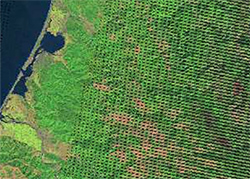Landsat
Introduction
The Landsat program has provided the longest, continuous global acquisition of satellite imagery. The Landsat program was the first unmanned satellite specifically designed to acquire data about the earth’s resources. The Earth Resources Technology Satellite (ERTS), later renamed Landsat 1, was launched in July 1972. The most recent version of Landsat, Landsat 8 was launched in 2013. Over the past 40 years, the Landsat program has acquired millions of images of the Earth. Landsat satellites capture images of the Earth’s surface along the satellite’s ground track in a 185-kilometer-wide swath as the satellite moves in a descending orbit (moving from north to south) over the sunlit side of the Earth. Landsat has a return time of approximately 16 days.
Landsat Timeline and Overview
The Landsat satellites have carried six different sensor types: Return Beam Vidicon (RBV), Multispectral Scanner (MSS), Thematic Mapper (TM), Enhanced Thematic Mapper (ETM), Enhanced Thematic Mapper Plus (ETM+) and the Operational Land Imager (OLI) and Thermal Infrared Sensor (TIRS). There have been a total of nine Landsat satellites in the Landsat program.
Landsat 1, 2 and 3
Landsat 1-3 were the first generation of Landsat satellites and were all launched in the 1970s. The early Landsats supported two sensor systems:
- Return Beam Vidicon (RBV)
- Multi-Spectral Scanner (MSS)
The Return Beam Vidicon (RBV) camera system was designed to obtain high resolution television pictures of the Earth. Three cameras were used to take pictures simultaneously in three different spectral bands (green-blue, orange-red and red-near infrared). The RBV was supposed to be the main instrument, but had technical problems and the MSS data produced multispectral data in digital format. On Landsat-1 the Return Beam Vidicon (RBV) Operated from July 23, 1972 to August 5, 1972, recording only 1692 images.
The Landsat Multispectral Scanner (MSS) sensor was onboard Landsats 1 through 5 and acquired images of the Earth nearly continuously from July 1972 to October 1992.
Landsat 4 and 5
Landsat 4 and Landsat 5 were launched in the early 1980s. When Landsat 5 was launched in 1984, it was designed with a three-year life span. Landsat 5 continued to produce high-quality imagery until 2011, officially setting a new Guinness World Records title for “Longest-operating Earth observation satellite. Landsat 4 and 5 carried the same sensors, the Multispectral Scanner System (MSS) and the Thematic Mapper (TM) instruments.
Multispectral Scanner (MSS)
The Landsat Multispectral Scanner (MSS) images consist of four spectral bands ranging from the visible green to the near-infrared (IR) wavelengths with 60 meter spatial resolution. Approximate scene size is 170 km north-south by 185 km east-west (106 mi by 115 mi). Specific band designations differ from Landsat 1-3 to Landsat 4-5. *Note that the original MSS pixel size was 79 x 57 meters; the production systems now resample the data to 60 meters.
| Landsat 1-3 | Landsat 4 & 5 | Wavelength in Micrometers |
Spatial Resolution |
|---|---|---|---|
| Band 4 | Band 1 | 0.5-0.6 (Green) | 60 meters* |
| Band 5 | Band 2 | 0.6-0.7 (Red) | 60 meters |
| Band 6 | Band 3 | 0.7-0.8 (NIR) | 60 meters |
| Band 7 | Band 4 | 0.8-1.1 (NIR) | 60 meters |
Thematic Mapper (TM)
The Thematic Mapper (TM) instrument was carried on Landsat 4 and 5. Landsat TM images consist of seven spectral bands with a spatial resolution of 30 meters for Bands 1 to 5 and 7. Spatial resolution for Band 6 (thermal infrared) is 120 meters, but has been resampled to 30-meter pixels.
| Landsat 4 & 5 | Wavelength in Micrometers | Spatial Resolution |
|---|---|---|
| Band 1 | 0.45-0.52 (Blue) | 30 meters |
| Band 2 | 0.52-0.60 (Green) | 30 meters |
| Band 3 | 0.63-0.69 (Red) | 30 meters |
| Band 4 | 0.76-0.90 (NIR) | 30 meters |
| Band 5 | 1.55-1.75 (SWIR 1) | 30 meters |
| Band 6 | 10.40-12.50 (Thermal) | 120 meters (30m) |
| Band 7 | 2.08-2.35 (SWIR 2) | 30 meters |
Landsat 6
Landsat 6 was launched in 1993 but failed to achieve orbit. Landsat 6 carried an Enhanced Thematic Mapper, but no data was ever collected since the satellite failed to reach orbit. As a consequence, Landsat 4 and Landsat 5 were used well beyond their designed lifespan.
Landsat 7

Landsat 7 was launched in 1999 to continue the Landsat mission of providing up-to-date global satellite images. The main instrument on board Landsat 7 is the Enhanced Thematic Mapper Plus (ETM+). The ETM+ includes a panchromatic band (Band 8) with increased spatial resolution at 15 meters. On May 31, 2003 the Scan Line Corrector (SLC) in the ETM+ instrument failed. The sensor scans back and forth to capture the images, the purpose of the SLC is to align the scans. Imagery acquired after the SCL stopped working has gaps, and appears to have "stripes" where data is missing. The SLC-off effects are most pronounced along the edge of the scene and gradually diminish toward the center of the scene. There are some techniques that can be used to "fill-in" the missing data. Landsat 5 TM data is a good substitute, as it is available from 2003 to 2011 has similar resolution but lacks the "striping".
Enhanced Thematic Mapper Plus (ETM+) (Landsat 7)
| Landsat 7 | Wavelength in Micrometers | Spatial Resolution |
|---|---|---|
| Band 1 | 0.45-0.52 (Blue) | 30 meters |
| Band 2 | 0.52-0.60 (Green) | 30 meters |
| Band 3 | 0.63-0.69 (Red) | 30 meters |
| Band 4 | 0.77-0.90 (NIR) | 30 meters |
| Band 5 | 1.55-1.75 (SWIR 1) | 30 meters |
| Band 6 | 10.40-12.50 (Thermal) | 60 meters (resampled to 30m) |
| Band 7 | 2.08-2.35 (SWIR 2) | 30 meters |
| Band 8 | .52-.90 (Panchromatic) | 15 meters |
Landsat 8
Landsat 8 launched in 2013, originally called the Landsat Data Continuity Mission (LDCM), is a collaboration between NASA and the United States Geological Survey (USGS). Landsat 8 carries two sensors, the Operational Land Imager (OLI) and the Thermal Infrared Sensor (TIRS). Landsat 8 has improved resolution, with 12-bit radiometric resolution and more bands (greater spectral resolution) compared to earlier Landsats.
Operational Land Imager (OLI) and Thermal Infrared Sensor (TIRS)
| Landsat 8 | Wavelength in Micrometers | Spatial Resolution |
|---|---|---|
| Band 1 | 0.43-0.45 (Coastal aerosol ) | 30 meters |
| Band 2 | 0.45-0.51 (Blue) | 30 meters |
| Band 3 | 0.53-0.59 (Green) | 30 meters |
| Band 4 | 0.64-0.67 (Red) | 30 meters |
| Band 5 | 0.77-0.90 (NIR) | 30 meters |
| Band 6 | 1.57-1.65 (SWIR 1) | 30 meters |
| Band 7 | 2.11-2.29 (SWIR 2) | 30 meters |
| Band 8 | 2.08-2.35 (SWIR 2) | 30 meters |
| Band 9 | 0.50-0.68 (Panchromatic) | 15 meters |
| Band 10 | 10.60-11.19 (Thermal 1) | 100 meters (resampled to 30m) |
| Band 11 | 11.50-12.51 (Thermal 2) | 100 meters (resampled to 30m) |
Landsat 9
Landsat 9 is the most recent satellite in the Landsat program and was launched in September of 2021. Landsat 9 carries two sensors, the Operational Land Imager (OLI-2) and the Thermal Infrared Sensor (TIRS-2). The two sensors have the same spectral and spatial resolution as the original sensors on Landsat 8 but feature improved radiometric resolution with 14-bit dynamic range.
Explore: Google Earth Engine Timelapse
Google Earth Engine is a large catalog of satellite imagery and geospatial datasets that are available to scientists, researchers, and developers. One of the Google Earth Engine projects in Timelapse, which provides global imagery for the past 32 years and allows you to create timelapses of any area on the planet. Over 5 million satellite images acquired over the past three decades by 5 different satellites but the vast majority of the images came from Landsat . You can search, pan, or zoom around the entire Earth and explore how the Earth has changed over the past three decades. Below is a timelapse of the greater Las Vegas, Nevada region. Click the play button to animate the imagery. Visit the Timelapse site to search for locations by name and explore the imagery.
